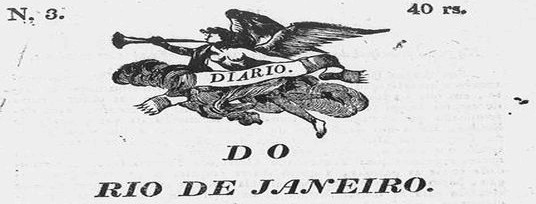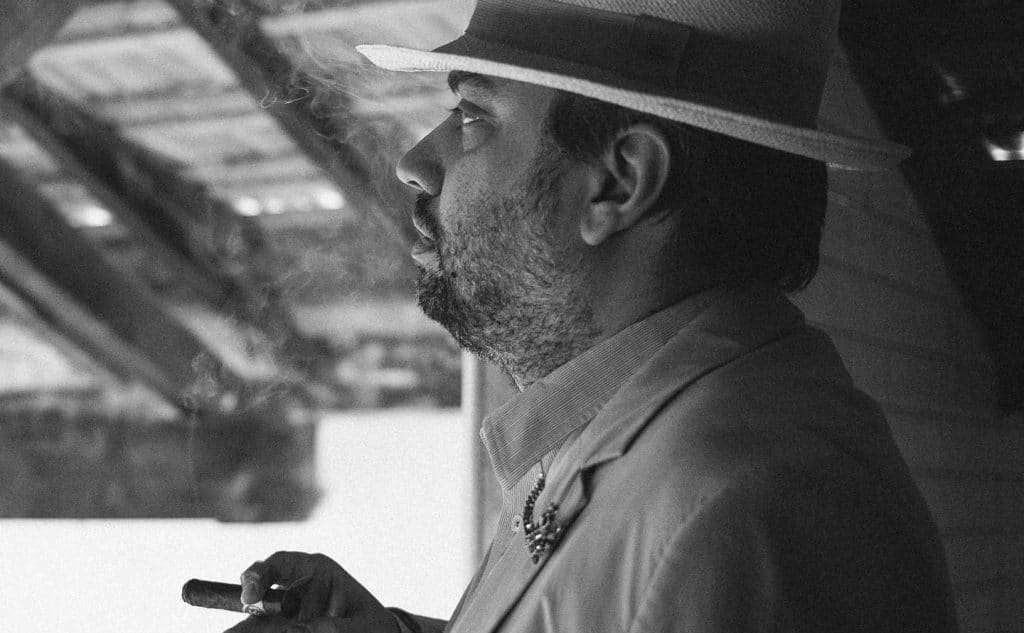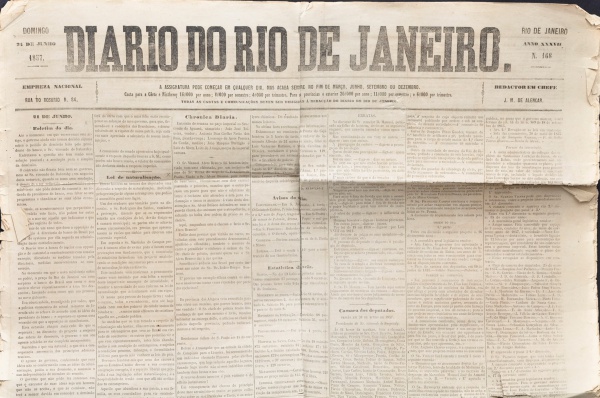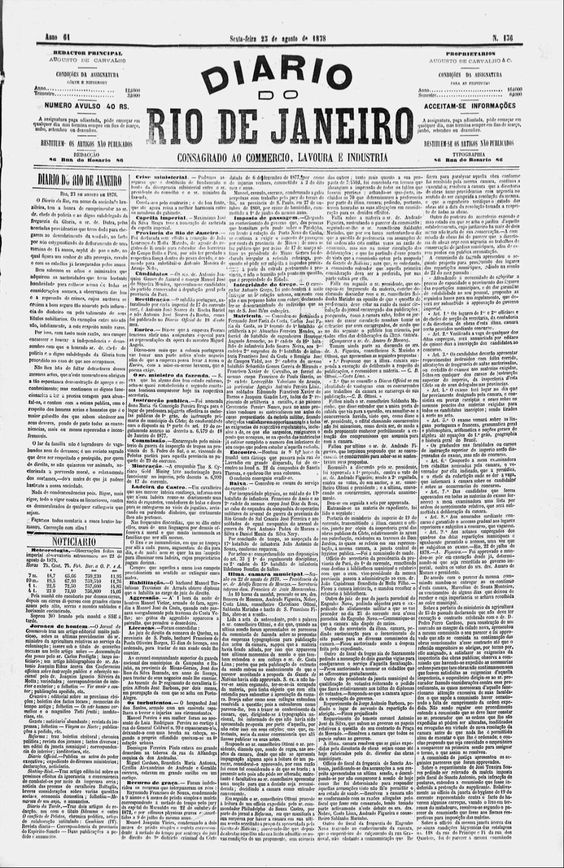
The Diário do Rio de Janeiro, or the Diário do Rio, as the Cariocas have affectionately called it, was the country’s first daily newspaper, beginning to circulate on 1 June 1821, even before Brazil’s independence. Now, in 2021, it completed 200 years. That’s right, 200 years!
Initially printed in its own print shop, Tipografia do Diário, the newspaper had as its first editors Zeferino Vitor de Meireles and Antônio Maria Jaurdan. Having already an eye on the local news, Meireles spread around the city some “news collecting boxes”, where people could insert papers with what they believed would be interesting to be published.
According to most historians, the Diário do Rio de Janeiro in its early years was a more informative newspaper, without an editorial line that interfered in the daily life of the imperial court. But it was so informative that it ended up contributing to the daily life of the Cariocas of the time, to the extent that, according to historian Laiz Perrut Marendino, “it brought the public an idea of life in society by bringing together in its pages a large number of different ads, official news from the imperial government, news from foreign countries, inventions, news of the sciences, medicine, literature and everything else that it considered useful to its readers”.
Because it was a newspaper that was sold at very modest prices – which earned it the nickname ‘the butter diary’, since it cost the same as a small portion of butter – it had immense distribution and reach. Besides, the number of ads published on its pages was so large – very similar (internal joke) to what happens today in our online version so full of banners and videos that annoy our reader so much nowadays – that it was almost a kind of “yellow pages” of Rio de Janeiro at the time. Whatever you wanted in the imperial court, you could find it in the Diário do Rio.
Starting more or less in 1830, and after supporting and defending Brazil’s independence, the years went by and the newspaper began to have a much more politicized editorial line, and to take a stand to promote the ideas of the so-called “Caramurus,” who were the members of the former Partido Restaurador (Restoration Party). These were mostly Portuguese merchants, bureaucrats and military men who wanted Emperor Pedro I to return to Brazil, after he had abdicated in favor of his son. They defended a more centralized and almost absolutist monarchy. But Pedro I died in 1834, undermining this political movement.
In the subsequent period, the Diário was very active in the field of literature, publishing essays, articles, short stories, and even holding – for decades – the famous “Semana Literária” (Literary Week), in which some of the leading names in Brazilian literature of the time took part. In this period, there were times when the news even took a back seat; but the newspaper never stopped carrying ads and local news.

During the regencies and especially after Pedro I’s death – for those who are more distracted, we remember that Pedro II became Emperor when he was still a minor, and until he was 15, the country was governed by successive regencies, going through a great deal of instability – the Diário do Rio began to dedicate itself much more decisively to political discussion, without ever leaving aside its informative bias, the daily life of the Cariocas and the Fluminenses, the advertisements, and the political fight. Exactly as we do nowadays.
“[…] Until now the Diário had abstained from political issues; from the beginning of the year on we will devote some columns to this important matter. This will not prevent us from registering in our pages the most important events in foreign countries; […]”
The Diário do Rio de Janeiro, January 2, 1845
At this point, the editorial staff announced that the newspaper would begin to feature opinion columns on the most important topics in the court, the city, and the country. After that, we grew exponentially, embracing more political themes, opinion columnists – exactly as we do now – and the newspaper also started to have a large international news section, including an international correspondent in Lisbon.
In 1855 a major financial crisis affected the Diário, which was eventually sold to the writer José Martiniano de Alencar, who, in 1856, hired José de Alencar as editor-in-chief. After that, the final part of the front page of each edition comes with literary pamphlets by authors who would eventually become some of the country’s greatest writers.
Between 1858 and 1960 the crisis hit the newspaper again, and on December 10, 1858 it stopped being printed daily, returning on the 16th, under the name “O Velho Diário do Rio de Janeiro”, explaining the reasons for the crisis, caused by political persecutions.
Names such as Machado de Assis, Quintino Bocaiúva, Ferreira Vianna, Saldanha Marinho, and José de Alencar himself wrote in the Diário do Rio. Quintino Bocaiuva replaced José de Alencar as director of the newspaper, resuming printing on March 25, 1860. The eminent republican Saldanha Marinho took over as chief editor. Bocaiuva was the correspondent in the Imperial Senate, and in the following years began to use the newspaper’s space to defend republican ideals, and the promotion of immigrant labor, as an alternative to slave labor, but he eventually left the Diário.
In 1867, the newspaper is sold to Sebastião Gomes da Silva Belfort, and has 5 great editors, which is followed by a period of prosperity, with great writers and many literary texts by great masters.
In its final print phase, “consecrated to commerce, farming and industry”, as its slogan at the time said, it lasted until 1878. Its headquarters was located first in Rua do Ouvidor, and then in Rua do Rosário, 86, a few meters from our new headquarters, at Travessa do Comércio, in the historic Arco do Teles. On October 31, 1878, its last printed edition is distributed, informing the “end” of the newspaper.
From a return as a blog to a respected digital newspaper

129 years had passed. In 2007, the (then) young sub-mayor of Ilha do Governador, Quintino Gomes Freire, advised and encouraged by friends and supporters, especially Breno Arruda, verifies that there is simply no media that looks at Rio de Janeiro with good eyes, praising everything positive, and criticizing (only) what is effectively negative and striking. Rio de Janeiro now has such a “cosmopolitan” press that it forgets to look at its own navel; to follow its own politics; to worry about its own destiny. The unison voices of the Carioca press at that time turned exclusively to armed robberies, drugstore robberies, and the problems that afflict the entire Brazilian population. Only about Rio? There doesn’t seem to be anyone left.
This is how the ‘blog’ phase of the Diário do Rio was born. With no funds, no permanent staff, but with a surprising number of readers and an unbelievable audience. The small ‘blog’ grows very quickly, reaching thousands of daily hits, hundreds of thousands of followers on the social networks, and an immense audience that makes it attract several advertisers interested in appearing to so many young people, effectively interested in what is good about Rio de Janeiro. In this period the immense movement caused by the pioneering List of Carnival Street Parties of the Diário was noteworthy, where, for the first time, an itinerary of the street carnival parties was organized, with schedules, summary of activities, and much more.
The growth is exponential, until the financial crisis that hit Rio after the big events (World Cup and Olympics), and everything becomes more difficult. Changes in the social network algorithms demand greater investments, more articles, more staff, changes. And the big blog – which in fact was a small business – is put up against the wall: either it becomes professional and moves several houses forward, or it becomes a hobby of its founder.
The couple Bruna and Cláudio André de Castro, both readers and advertisers of the blog through the family’s traditional real estate company, see potential in the business, and decide to invest in its professionalization. It all begins with the purchase of the Diário do Rio’s main building, a historic 18th century manor house located in a prime location in downtown Rio – the Arco do Telles, in the heart of Praça XV (or Largo do Paço) – and the setting up of a newsroom, including the hiring of several collaborators, new graphic planning, investment in advertising, professional internet and a huge publicity campaign.
The deal was entered in late 2018, and the company, now structured as a real newspaper, passes to the control of the Castro family, under the direction of its usual Editor-in-Chief, Quintino Gomes, who, alongside Ivana Luterbark, remains at the reins of the daily operation of the newspaper, which finally joins the Brazilian Association of Newspapers (Associação Nacional de Jornais), and starts to have a permanent staff of journalists and collaborators in its newsroom, as well as a team of social media specialists. During this period, the number of visitors to the diariodorio.com website begins to soar.

Noting that there is room for a great newspaper that deals with positive news about Rio de Janeiro, the Carioca and Fluminense politics, events agenda, restaurants, bars, pubs and nightclubs, as well as the insides of the state and city legislative houses, the new direction invests in this niche. While the city’s largest newspaper is proud to declare itself ‘a nationwide newspaper,’ the Diário do Rio de Janeiro becomes “Rio’s main regional newspaper,” focusing on local news and not prioritizing criminal matters. Independent, completely disconnected from the interests of any media group, the Diário quickly becomes the focus of the whole Brazilian press on what is from Rio de Janeiro. Everything that happens in Rio is published here first.
The result is fast. From an average of 400,000 monthly visitors in 2018, in 2019 the average exceeded 3 million readers. In the 2020 elections, the newspaper reaches 10 million monthly readers, maintaining local coverage of the elections for mayors and councilors never seen before in Rio. More than 50 hours of interviews were conducted with mayoral and city council candidates. A single report on the city council candidates we interviewed had 700,000 visitors on election day alone.
The Diário do Rio joins the Digital Journalism Association (Associação de Jornalismo Digital) and the Rio de Janeiro Trade Association (Associação Comercial do Rio de Janeiro) the same year it receives its first award, in 2021. Reports nominated for journalistic awards, such as the one written about the risks of existing dams in Rio de Janeiro, have millions of hits. Like the old Diário of the 19th century, the newspaper now publishes columns by well-known Carioca politicians of the most diverse political currents, from Chico Alencar to Rodrigo Amorim, and from Pedro Duarte to Paulo Pinheiro. Today the newspaper is a pioneer in discussions about the revitalization of the downtown area, and maintains an immense magnifying glass on city maintenance in the State of Rio de Janeiro.
Those who read these pages and the news from other vehicles about Rio end up realizing that everyone reads the Diário. Including the others. As our slogan says… those who love Rio, read it.











